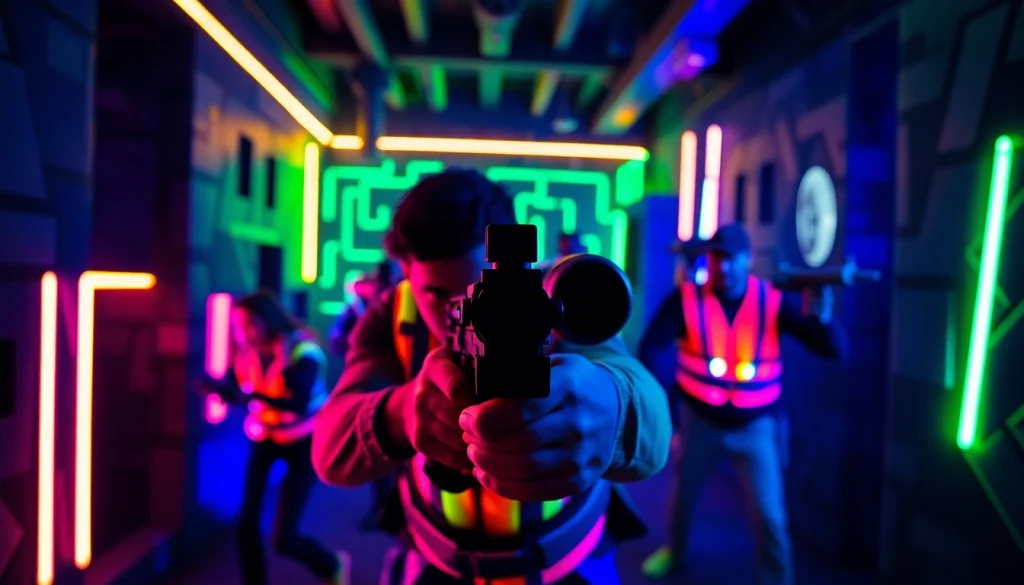Ultimate Guide to Laser Tag: Strategies, Benefits, and Venue Choices

Understanding Laser Tag: What You Need to Know
The Basics of Laser Tag
Laser tag is a popular recreational sport that combines elements of physical activity, strategy, and electronic gaming. Participants engage in team-based matches using infrared-emitting light guns to tag opponents and designated targets. The game’s objective varies, ranging from capturing flags to eliminating players, depending on the specific game mode. Unlike paintball, laser tag eliminates the mess and sting of projectiles, making it an appealing choice for all ages. In many venues, players wear vests equipped with sensors that interact with the light guns, allowing for a scoring system that tracks hits, misses, and player performance.
This exciting activity is suitable for both children and adults, making it a great option for birthday parties, corporate events, family outings, and more. Laser tag arenas are often designed with various obstacles and creative theming to enhance gameplay and immerse players in the experience. To learn more about available laser tag options near you, consider visiting laser tag event sites that offer unique setups and entertainment.
How Laser Tag Works
Each laser tag match begins with players being equipped with a laser tag gun and a vest or a harness that detects hits. Players aim their guns at opponents or targets and shoot infrared beams. When an opponent is hit, sensors in their vest register the hit, and an audible or visual signal indicates the event. The experience combines elements of video game mechanics with physical action, making it both competitive and fun.
Games typically last between 10 to 30 minutes, determined by the venue and game type. Participants usually receive a briefing before the match, explaining the rules and objectives to ensure everyone understands how to play effectively.
Different Types of Laser Tag Games
Laser tag comes in several variants, each offering unique twists on the traditional gameplay. Here are a few common types:
- Team Deathmatch: Players are divided into teams, aiming to tag opponents while protecting their own team members.
- Capture the Flag: Teams strive to capture a flag located in the opposing team’s territory while defending their flag.
- Domination: Players must control specific areas of the arena to earn points.
- Last Man Standing: A free-for-all game where the last player remaining without being tagged wins.
The variety of game modes enhances the overall experience and allows players to engage differently, encouraging teamwork and strategy to outwit opponents.
Choosing the Right Laser Tag Venue
Indoor vs. Outdoor Laser Tag
When selecting a laser tag venue, determining whether you prefer indoor or outdoor gameplay is crucial. Indoor arenas are typically smaller, offering intricate designs with obstacles that require players to employ stealth and strategy. These controlled environments can be designed with a variety of themes, from futuristic sci-fi landscapes to haunted houses.
Outdoor laser tag, on the other hand, usually provides a more expansive playing field, allowing for varied terrain and natural hiding spots. Outdoor venues might include features like forests, hills, and open fields, enabling more extensive and dynamic gameplay. Each type has its benefits, so consider the group’s preferences and age when deciding.
Top Venues for Laser Tag Experiences
Across the UK and beyond, there are numerous venues where you can participate in exhilarating laser tag experiences. While top venues may vary by region, some popular examples include:
- Laser Quest: Known for its iconic indoor arenas and comprehensive game styles, Laser Quest provides players of all ages with thrilling experiences.
- Adrenaline Alley: This venue often combines laser tag with other extreme sports, making it a great place for an action-packed day.
- Urban Air Trampoline Park: Featuring unique trampolining elements, this venue enhances the laser tag experience with added physical activity.
Before heading out, check reviews and community feedback about the venues to ensure they meet your expectations for safety, cleanliness, and overall fun.
What to Look for in a Laser Tag Facility
When choosing a laser tag facility, several factors are essential to ensure you have the best experience:
- Safety Standards: Ensure that the venue follows strict safety protocols and uses high-quality equipment.
- Game Variety: Look for venues that offer multiple game types to keep participants engaged and entertained.
- Facilities and Amenities: Consider venues that provide comfortable waiting areas, restrooms, and food options.
- Staff Expertise: An experienced staff can enhance the experience by providing instruction, guidance, and timely assistance during gameplay.
Conducting research online or visiting potential venues to observe their operations can provide insight into the quality of their offerings.
The Benefits of Playing Laser Tag
Physical Health Benefits
Engaging in laser tag offers several physical health benefits. The fast-paced nature of the game ensures participants remain active, improving cardiovascular health and promoting physical fitness. Many players will run, duck, and hide, which helps develop muscle endurance and agility.
Additionally, laser tag can be considered a form of high-intensity interval training (HIIT). The bursts of activity promote increased heart rates, which can facilitate weight loss and improve metabolic efficiency.
Cognitive Skills Enhancement
Laser tag is more than just physical activity; it enhances cognitive skills such as strategic thinking, quick decision-making, and teamwork. Players must constantly assess their environment, predict opponents’ movements, and devise tactics to gain an advantage, sharpening problem-solving abilities.
Furthermore, the game requires teamwork and collaboration, fostering communication skills and bolstering social interactions among participants. This strategic depth ingrains a sense of camaraderie as players work together to achieve common goals.
Team Building and Social Interaction
One of the most significant benefits of laser tag is its ability to foster teamwork and social bonds. Whether playing with friends, family, or colleagues, laser tag creates an environment that promotes collaboration and communication. Players must strategize together and rely on one another’s abilities to succeed, leading to strong team dynamics.
This team-building aspect makes laser tag an excellent choice for corporate outings, school trips, or family gatherings, giving participants an opportunity to connect and strengthen relationships in an engaging atmosphere.
Tips and Strategies for Success in Laser Tag
Essential Gear for Optimal Performance
While laser tag facilities typically provide all necessary equipment, understanding gear can impact your performance. Key components include:
- Laser Tag Gun: Familiarize yourself with the gun’s features, such as range and firing modes.
- Vest or Harness: Ensure it fits properly for optimal movement and comfort.
- Appropriate Clothing: Wear comfortable clothes that allow for easy movement. Closed-toe shoes, preferably sneaker-style, are essential for traction and support.
Pay attention to the specific equipment used at your venue, as various facilities may have different setups, accessories, and rules regarding gear.
Effective Game Strategies
To excel in laser tag, employing effective strategies can significantly improve your gameplay:
- Stay Mobile: Constant movement makes it harder for opponents to target you while allowing you to position yourself advantageously.
- Use Cover: Take full advantage of obstacles, walls, and barriers to shield yourself during engagement.
- Communicate with Your Team: Share information about enemy positions and coordinated tactics with teammates to enhance effectiveness.
Combining these tactics can create an effective plan tailored to your team’s strengths and weaknesses, helping you gain the upper hand.
How to Work as a Team
Effective teamwork is often the difference between victory and defeat in laser tag. Consider these tips to enhance your team’s coordination:
- Designate Roles: Assign specific roles based on players’ strengths, such as scouts, defenders, or attackers, to streamline gameplay.
- Plan Before the Match: Discuss strategies before the game begins, establishing clear communication channels and signals to use during gameplay.
- Assess and Adapt: Be prepared to change strategies based on the opponents’ tactics, keeping your gameplay dynamic.
Remember, laser tag is most enjoyable when played as a team. Cherish the shared experience while developing strategies together.
Frequently Asked Questions About Laser Tag
What is the Appropriate Age for Laser Tag?
Laser tag is generally suitable for children aged 6 and up. Younger children may struggle with the mechanics of the game or the physical demands it places on them. Most facilities have age guidelines; it’s important to check these before planning your visit to ensure suitability for all participants.
How Much Does Laser Tag Typically Cost?
The cost of laser tag can vary widely based on location and venue but generally falls within these ranges:
- Single Game (5–15 minutes): $7 – $12 per person
- Two Games Package: $12 – $20 per person
- Unlimited Play (Hourly or Day Pass): $20 – $35 per person
Booking in advance or choosing group packages may provide opportunities for savings.
Is Laser Tag Safe?
Laser tag is considered a safe activity, especially when conducted in controlled environments with proper equipment. The gear is designed to minimize injury risk, and venues typically have guidelines to ensure player safety. However, as with any physical activity, participants should exercise caution and ensure they are fit to engage in such gameplay, particularly in more intense environments.







